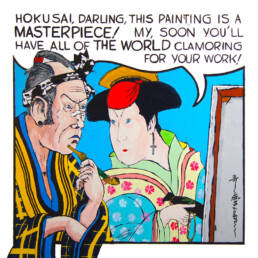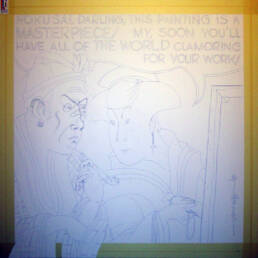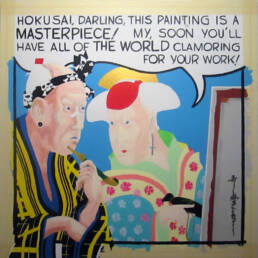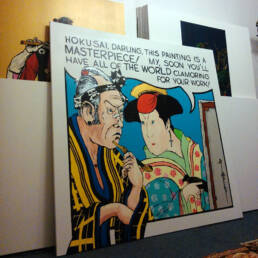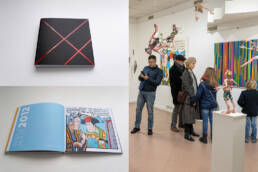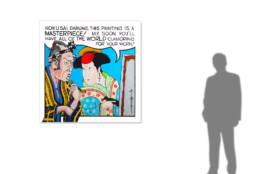Masterpiece
The first in the series of Utamaro Lichtenstein paintings. While the original painting somewhat ridicules the stereotypes of successful artist of the 60’s, I tried to present alternative Japanese version but in nowadays context. For the artist and his girlfriend I used Sharaku´s ōkubi-e, bust portraits, of Actor Iwai Hanshiro IV as Shigenoi, onnagata (male actor in a role of a woman), and Matsumoto Koshiro IV as Sakaya Gorobei holding a pipe. On my painting we have almost similar situation, but my characters here are different. Artist is an older man; Hokusai for example did his Great Wave off Kanagawa in his late 60ies, still hyped from painting all night. He is that kind of guy who partied with David Bowie and Iggy Pop in Berlin, we can see different piercing on his face, painted nails in black, he is someone who would listen to Korn’s music, his kimono is A.D.I.D.A.S. brand, he is bold and he wears cheap off the street skulls bandana. On the other side, instead of beautiful blondie, we see transvestite, who could be his friend, dealer, partner/lover. He has undergone plastic surgery, a bit deformed from cheap facelift; his earing is Madonna-like- a- Virgin- kind of statement. His kimono is flawless. Neither of the charters is Japanese in origin, they are Caucasians, New Yorkers. In this piece I combined a bit of reality with stereotypes promoted by TV reality shows.
I tried to emphasize comics- like features of the painting with breaking out of the frame, creating fake field of depth in this flat surfaced painting.
Technique: acrylic on canvas
Size: 147 x 147 cm (57.87 x 57.87 inch)
Year: February 2014
Availability: In Private Collection
Utamaro Lichtenstein
After presenting/exhibiting first series of paintings from the 100 Views of Ukiyo-e, I immediately started to think about further development of my idea that Pop art and most of the modern arts are rooted in Ukiyo-e. In the 100 Views of Ukiyo-e I am trying to present Ukiyo-e prints as contemporary art, by giving them new “original” painting, new source. In the process of painting, more or less, Ukiyo-e prints are modernized to achieve more global symbolism. What I noticed is that people still perceived my paintings as Japanese and even exhibitions are called Japanese art exhibitions, therefore failing to see that it became, in a way, Bosnian art, and that Ukiyo-e has still a strong global influence and should be perceived as one of the pillars of the global art, meaning not just Japanese/Asian but the World history of art.In the process of thinking I had to come back to the beginning of my research. My research began with American Pop art and my interest for the fine arts began when I saw Roy Lichtensten´s Whaam! painting in some art magazine or a book. Printed on the size of the regular comic frame, even with the size written underneath the print, what I saw were just comics being recognized as fine art. One year later, I applied to Academy of Fine Arts, Sarajevo. In the final year, I was able to research Pop art more actively and one thing led to another, and I ended up researching Ukiyo-e.
But what about Pop art and Lichtenstein and Ukiyo-e?
Lichtenstein’s work could be also perceived as Appropriation art, for its source comes from another visual medium. On the other hand, my art is mostly Appropriation art, and it usually deals with question of the copy and original. For example, all “original” subjects of my paintings are known to me through their printed or digital copies. I could only imagine their size, their colors, or their texture and surface relief. So my painting is alternative to original and in most cases it is alternated original. So if I say that Ukiyo-e is Pop art, am I not saying that Pop art is Ukiyo-e? And welcome to the birth of Utamaro Lichtenstein. It is a series of paintings that have source in Lichtenstein work, but they will be Japanized, as if Lichtenstein himself was Japanese, and we are all living in alternative universe where Eastern hemisphere and arts dominated over the Western. I chose name Utamaro, as it is one of the most mentioned artist who influenced Impressionism and I added Lichtenstein as in Ukiyo-e practice for artist to adopt family name of his school master. Painting will be comment to more contemporary subjects. As in early translations of Mangas (Japanese comics), where pages were mirrored to allow more left to right reading flow, all paintings will be mirrored to achieve right to left flow. All paintings will be signed as Utamaro Lichtenstein.

